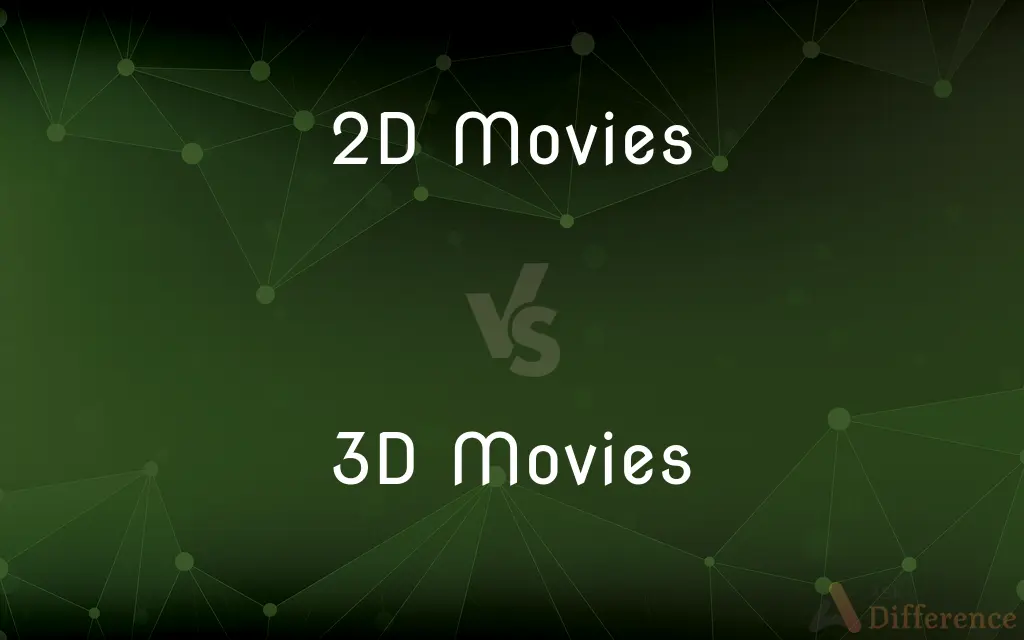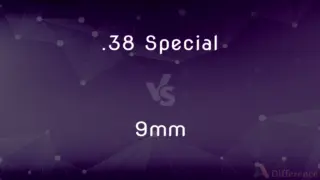2D Movies vs. 3D Movies — What's the Difference?
By Tayyaba Rehman & Urooj Arif — Published on February 16, 2024
2D movies display flat images with width and height, while 3D movies add depth perception, creating an illusion of three-dimensional space.

Difference Between 2D Movies and 3D Movies
Table of Contents
ADVERTISEMENT
Key Differences
2D movies project images that have width and height but lack depth, providing a traditional cinematic experience. 3D movies, however, utilize technology to add a third dimension, depth, creating a more immersive viewing experience by making the visuals appear to pop out of the screen. This difference fundamentally alters how viewers perceive and interact with the content, with 3D movies often requiring special glasses to achieve the effect.
While 2D movies are enjoyed without the need for additional accessories, 3D movies necessitate either polarized glasses or active shutter glasses to experience the depth effects. The technology behind 3D movies is more complex, involving the projection of two images simultaneously or the use of advanced digital effects to simulate depth. This complexity often translates to higher production and ticket costs for 3D movies.
The narrative and visual storytelling in 2D movies rely solely on traditional cinematography and animation techniques. In contrast, 3D movies can enhance storytelling by adding depth to visuals, making action scenes more exhilarating and animated characters more lifelike. However, the effectiveness of 3D technology greatly depends on the quality of its execution and the nature of the content.
Audiences with certain visual impairments might find watching 3D movies uncomfortable or unenjoyable, due to the strain of processing the dual-layered images into a single coherent scene. Meanwhile, 2D movies offer a universally accessible experience that doesn't pose the same risk of discomfort, making them a more inclusive option for all viewers.
The choice between 2D and 3D movies often comes down to personal preference, content, and accessibility. While 3D movies offer a novel and immersive experience, 2D movies continue to be a staple of cinema, appreciated for their classic appeal and straightforward presentation.
ADVERTISEMENT
Comparison Chart
Dimensionality
Two-dimensional (width and height)
Three-dimensional (width, height, and depth)
Viewing Requirements
No special glasses needed
Special glasses required (polarized or active shutter)
Production Complexity
Less complex, traditional cinematography
More complex, requires additional technology for depth effects
Viewer Experience
Traditional, flat visuals
Immersive, with visuals that can appear to extend out of the screen
Accessibility
Generally accessible to all audiences
Can cause discomfort for some viewers with visual impairments
Compare with Definitions
2D Movies
2D movies represent the classic form of cinema, relying on artistic and directorial vision for impact.
Pulp Fiction showcases the power of 2D storytelling through its innovative narrative structure.
3D Movies
3D movies often come with higher production and ticket costs due to the advanced technology required.
Life of Pi showcases the use of 3D for both its aesthetic beauty and narrative depth.
2D Movies
2D movies are films with images that have only width and height, offering a flat visual experience.
The Lion King is a classic example of a 2D movie with its traditional animation style.
3D Movies
In 3D movies, characters and objects can seem to jump out of the screen, enhancing viewer engagement.
The Avengers features action-packed scenes that are enhanced by 3D effects.
2D Movies
2D movies use traditional animation or cinematography techniques without depth effects.
Casablanca is celebrated for its 2D black and white cinematography.
3D Movies
3D movies can offer a unique and immersive storytelling experience, differentiating them from 2D films.
Finding Nemo in 3D brings the underwater world to life, making the audience feel submerged in the ocean.
2D Movies
In 2D movies, visuals are presented on a single plane, focusing on narrative and character development.
Toy Story, while created with 3D animation technology, was presented as a 2D movie to audiences.
3D Movies
3D movies add a depth dimension to the viewing experience, creating a sense of physical depth.
Avatar revolutionized cinema with its groundbreaking 3D visuals.
2D Movies
2D movies are often more accessible, requiring no special equipment for viewing.
Snow White and the Seven Dwarfs can be enjoyed by viewers without the need for 3D glasses.
3D Movies
3D movies require special glasses to view the intended depth effects and immersive experience.
Gravity utilizes 3D technology to simulate the vastness and depth of space.
Common Curiosities
Are 3D movies more expensive to produce than 2D movies?
Yes, the production of 3D movies involves additional technology and techniques, often leading to higher costs.
What is the main difference between 2D and 3D movies?
2D movies display images with width and height, while 3D movies add depth, creating a more immersive experience.
Can everyone enjoy 3D movies?
Some viewers may experience discomfort or cannot perceive the depth effects in 3D movies due to visual impairments.
Do all cinemas offer 3D movie screenings?
Not all, but many cinemas are equipped to screen 3D movies, especially in major cities and for blockbuster releases.
Do 2D movies offer any advantages over 3D movies?
2D movies are universally accessible, do not require special glasses, and are often less expensive for viewers.
Are animated movies only made in 2D?
No, animated movies can be made in both 2D and 3D formats, depending on the desired visual effect.
Is the storyline of a 3D movie different from a 2D movie?
The storyline can be the same, but 3D movies may enhance the visual experience to complement the narrative.
Are 3D movies better than 2D movies?
It's subjective; 3D movies offer a unique, immersive experience, while 2D movies are appreciated for their classic appeal.
Do I need special glasses to watch 3D movies?
Yes, 3D movies require special polarized or active shutter glasses to view the depth effects.
Can 2D movies be converted into 3D?
Yes, through a process called post-conversion, but the quality of depth perception varies compared to movies originally shot in 3D.
Why do some people prefer 2D movies over 3D?
Preferences vary; some find 3D glasses uncomfortable or the tickets too expensive, while others prefer the traditional 2D aesthetic.
Can 3D effects be enjoyed at home?
Yes, with a 3D TV and compatible glasses, viewers can enjoy 3D movies at home.
Is the popularity of 3D movies increasing?
The popularity varies; some audiences love the immersion of 3D, while others prefer the simplicity of 2D.
Can 3D movies cause motion sickness?
Yes, some viewers may experience motion sickness or discomfort when watching 3D movies due to the depth effects.
How do 3D glasses work?
3D glasses work by filtering the light that reaches each eye, creating the illusion of depth by presenting slightly different images to each eye.
Share Your Discovery

Previous Comparison
Cage-Free Eggs vs. Free-Range Eggs
Next Comparison
.38 Special vs. 9mmAuthor Spotlight
Written by
Tayyaba RehmanTayyaba Rehman is a distinguished writer, currently serving as a primary contributor to askdifference.com. As a researcher in semantics and etymology, Tayyaba's passion for the complexity of languages and their distinctions has found a perfect home on the platform. Tayyaba delves into the intricacies of language, distinguishing between commonly confused words and phrases, thereby providing clarity for readers worldwide.
Co-written by
Urooj ArifUrooj is a skilled content writer at Ask Difference, known for her exceptional ability to simplify complex topics into engaging and informative content. With a passion for research and a flair for clear, concise writing, she consistently delivers articles that resonate with our diverse audience.
















































